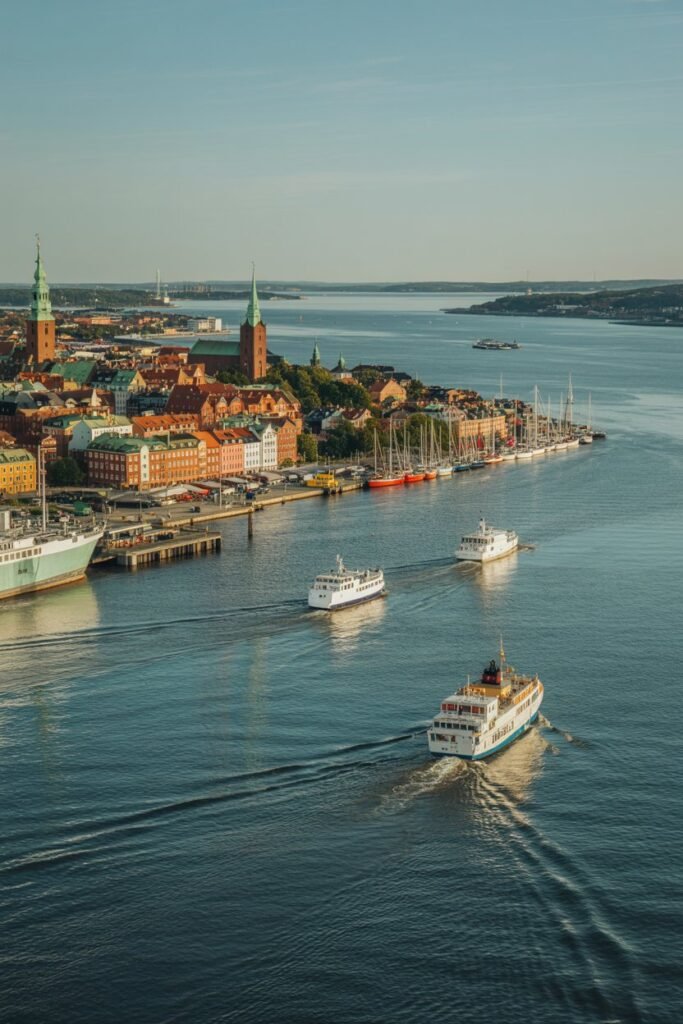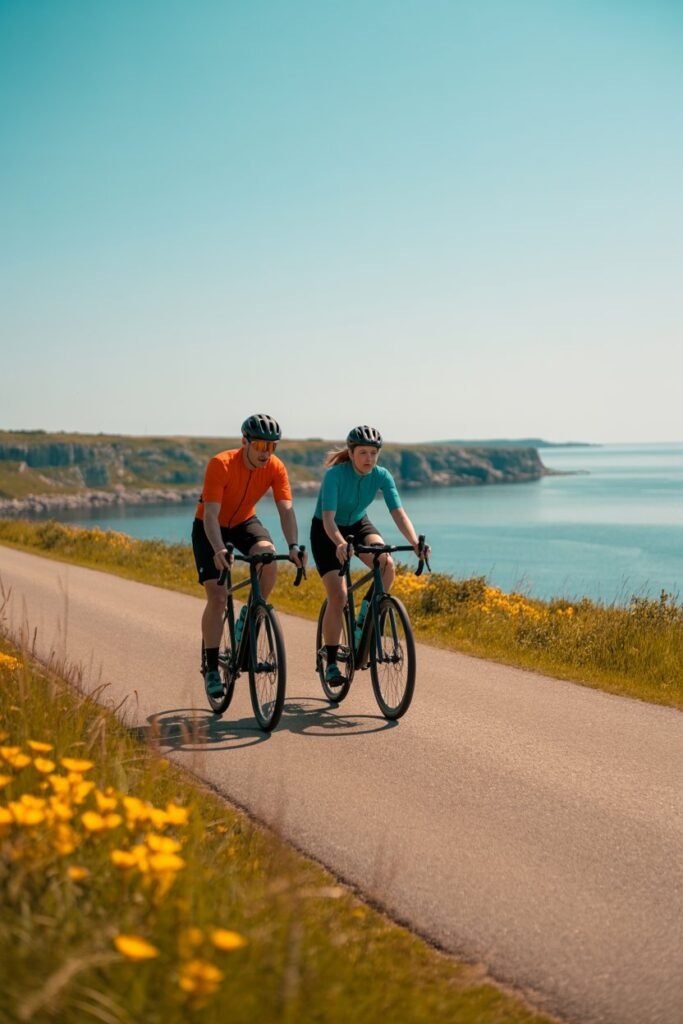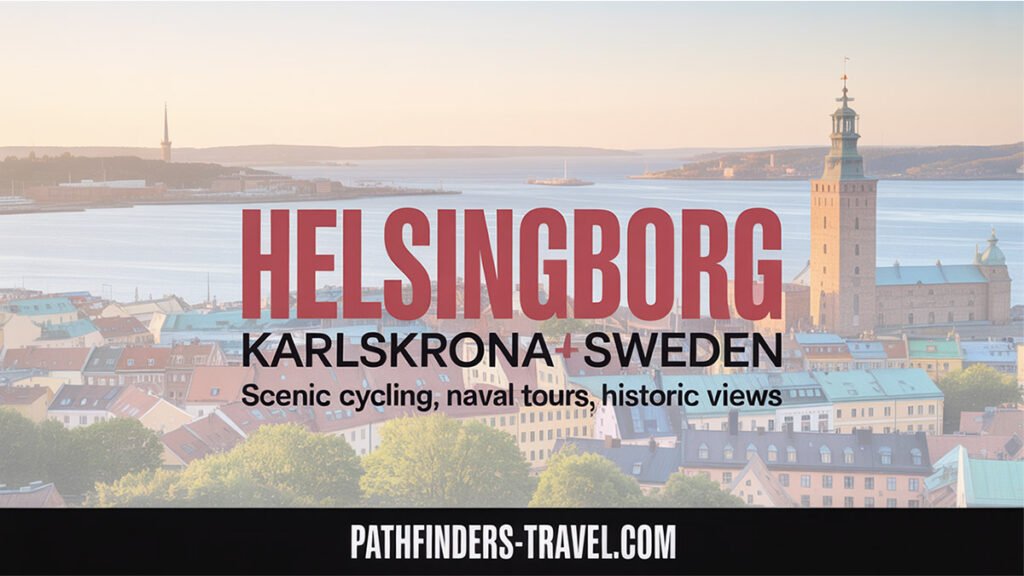Estimated reading time: 23 minutes
Key Takeaways
- Helsingborg offers a perfect blend of medieval heritage and modern coastal charm, with the iconic Kärnan Tower as its centerpiece
- Karlskrona Naval Base is a UNESCO World Heritage Site featuring impressive Baroque architecture and Sweden’s largest wooden church
- The Öresund Strait connects Helsingborg to Denmark, making it a strategic historical gateway to Sweden
- Cycling along Helsingborg’s coast is popular on the Kattegattleden national cycling trail, offering scenic routes and coastal views
- Both cities can be explored in a combined itinerary, showcasing Sweden’s southeastern coastal heritage
Table of Contents
- Introduction: Karlskrona–Helsingborg Coastal Guide and Itinerary OverviewBare
- Karlskrona Naval Base Tour (UNESCO World Heritage)
- Helsingborg travel guide: History, Things To Do, and Öresund Gateway
- Cycling the Helsingborg Coast
- FAQ: Karlskrona Naval Base Tour and Helsingborg Travel Guide
- Conclusion & Practical Information for the Karlskrona Naval Base Tour and Helsingborg Itinerary
Introduction: Karlskrona–Helsingborg coastal guide and itinerary overview
This guide pairs Blekinge’s UNESCO naval city of Karlskrona with Skåne’s coastal hub of Helsingborg on Sweden’s southern coast. Sweden’s southeastern coast is a region where maritime heritage and cultural richness converge to create an unforgettable travel experience. This coastal stretch has played a pivotal role in shaping Sweden’s history, from its naval defenses to its cultural exchanges with neighboring countries across the Baltic Sea. Today, this legacy lives on in the historic towns that dot the coastline, offering visitors a unique glimpse into Sweden’s past while enjoying its present-day attractions.
Among these coastal gems, Karlskrona and Helsingborg stand out as gateways to Sweden’s maritime past. Karlskrona, with its impressive naval base and the largest wooden church in Sweden, showcases the country’s seafaring might and architectural innovation. Meanwhile, Helsingborg, with its medieval roots and modern waterfront, offers a fascinating blend of historical depth and contemporary charm that makes it a must-visit destination on any helsingborg travel guide.
These southeastern coastal towns serve as perfect starting points for exploring Sweden’s rich cultural tapestry. From the well-preserved Baroque architecture of the karlskrona naval base tour to the panoramic views from Kärnan Tower in Helsingborg, visitors can experience centuries of Swedish history while enjoying the natural beauty of the Baltic coastline. Whether you’re interested in maritime history, medieval architecture, or simply enjoying the scenic coastal landscapes, Sweden’s southeastern coast offers something for every traveler.
Want to see this for yourself? Click here to jump to the video in UHD 4K Resolution.
Karlskrona Naval Base Tour (UNESCO World Heritage)
Karlskrona maritime legacy and UNESCO World Heritage status
The Karlskrona naval base stands as a testament to Sweden’s historical maritime power and architectural ingenuity. Founded in 1680 by King Karl XI, Karlskrona was strategically established as the primary base for the Swedish Baltic fleet. The king recognized the value of this location for its ice-free harbor and strategic position, making it ideal for naval operations throughout the year [SOURCE].
What makes Karlskrona truly remarkable is its well-preserved Baroque architecture and urban planning. The city was designed with a grid pattern typical of the Baroque period, featuring grand avenues, impressive public buildings, and a layout that centered around naval functions. This exceptional preservation of a complete 17th-century planned naval city led to Karlskrona’s designation as a UNESCO World Heritage Site in 1998, recognizing its outstanding universal value [SOURCE].
The naval base’s architecture reflects both practical military considerations and the aesthetic principles of the Baroque era. Visitors exploring the site can appreciate how the design integrated defensive needs with civic grandeur, creating a harmonious city that served both military and civilian purposes.
Active Karlskrona naval base tour (operational site access)
Unlike many historical military sites that have been completely converted to tourism, the karlskrona naval base tour offers a unique experience as it remains an operational military facility to this day. This creates a fascinating juxtaposition where visitors can witness both historical artifacts and contemporary naval activities side by side [SOURCE].
Parts of Karlskrona’s naval infrastructure remain active. Public experiences are centered on the Marinmuseum and historic sites like Drottningskär Citadel (Aspö). Access to certain forts (e.g., Kungsholms fort) is by special guided tour with booking and ID; availability varies.
The tour includes visits to the impressive historic dry docks, some of which date back to the 18th century. These engineering marvels showcase the advanced maritime technology of their time and provide insight into how naval vessels were constructed and maintained centuries ago. The sheer scale of these facilities demonstrates the importance placed on naval power during Sweden’s imperial era.Is Karlskrona’s naval base open to the public?
Equally impressive are the extensive fortifications that protected the naval base. Visitors can explore island bastions, defensive walls, and strategic watchtowers that once guarded Sweden’s valuable fleet. These structures not only tell the story of historical military engineering but also offer spectacular views of the surrounding archipelago.
Throughout the base, the presence of naval cadets and active military personnel creates a sense of living heritage, connecting the past to the present and illustrating how Sweden’s naval traditions continue to evolve while honoring their historical roots.
Sweden’s largest wooden church: Admiralty Church (Amiralitetskyrkan), Karlskrona
Among Karlskrona’s architectural treasures, the Admiralty Church (Amiralitetskyrkan) stands out as a unique cultural landmark. Built in 1685, this ochre-colored structure holds the distinction of being sweden’s largest wooden church and one of the largest timber ecclesiastical buildings in Northern Europe.
The church’s architectural significance stems from its impressive scale achieved using traditional timber construction techniques. Built in a simple yet elegant Baroque style, the church features a boxy design with a distinctive tower that has become an iconic part of Karlskrona’s skyline.
Originally constructed to serve naval personnel stationed at the base, the Admiralty Church continues to be a functional place of worship while also welcoming visitors interested in its historical and architectural value. Inside, visitors can admire the simple but beautiful wooden interior, featuring hand-carved details and maritime-themed decorative elements that reflect its naval heritage.
The preservation of this wooden structure for over three centuries is remarkable, especially considering the materials used and the harsh coastal climate. It stands as a testament to both the craftsmanship of its builders and the ongoing commitment to maintaining Sweden’s cultural heritage.
Karlskrona naval base tour: practical tips for visitors
To make the most of your karlskrona naval base tour, consider the following practical information:
- Tour Schedules: Guided tours of the naval base typically operate daily during summer months (June-August) and on weekends during the shoulder seasons. During winter (November-March), tours may be less frequent, so checking ahead is advisable.
- Tickets and Reservations: Some sections of the active base require advance booking or special permission. The Naval Museum offers comprehensive tickets that include access to various parts of the historical facilities.
- Visiting Times: Morning visits often provide the best experience with smaller crowds, especially during peak summer season. Allow at least 3-4 hours to properly explore the naval base complex and Admiralty Church.
- Photography Restrictions: As parts of the base remain active military installations, photography may be restricted in certain areas. Always follow guide instructions regarding photography.
For the best visitor experience, consider these insider tips:
- Join a guided tour rather than self-guided exploration, as guides can provide access to areas not open to the general public and share fascinating historical details.
- Wear comfortable walking shoes as the naval base covers a considerable area with various terrain types.
- Check if the Admiralty Church is hosting any concerts or special events during your visit, as experiencing music in this wooden structure with its unique acoustics can be particularly memorable.
- Consider combining your naval base visit with a boat tour of the surrounding archipelago for a more complete understanding of Karlskrona’s maritime setting.
Helsingborg travel guide: history, things to do, and Öresund gateway

Helsingborg history and cultural overview (Öresund Strait gateway)
Perched along the narrowest part of the Öresund Strait, Helsingborg has played a pivotal role in Scandinavian history for centuries. This strategic location, with Denmark visible just 4 kilometers across the water, has shaped the city’s development and historical significance as a crucial gateway to Sweden [SOURCE].
The helsingborg travel guide history begins well before the medieval period, with archaeological evidence suggesting settlements dating back to the Stone Age. However, it was during the Middle Ages that Helsingborg rose to prominence as a vital trading post and military stronghold. The city’s strategic importance led to it changing hands numerous times between Danish and Swedish rule throughout history.
This historical back-and-forth between Denmark and Sweden is central to understanding Helsingborg’s unique cultural identity. The city didn’t become permanently Swedish until the Treaty of Roskilde in 1658, though Denmark attempted to recapture it several times afterward. This shared heritage has created a distinctive cultural blend that differs from inland Swedish cities, with architectural influences and traditions from both countries visible throughout the urban landscape [SOURCE].
Today, Helsingborg stands as Sweden’s eighth-largest city and serves as an important transportation hub, connecting Sweden to Denmark via frequent ferry services. This continuous exchange of people and ideas has fostered a cosmopolitan atmosphere that blends seamlessly with the city’s historical character.
Helsingborg medieval heritage and modern waterfront
Helsingborg’s old town offers visitors a delightful journey through centuries of architectural evolution. Compact and walkable, this historical core features a captivating mix of medieval remnants, Renaissance buildings, and 19th-century structures that together tell the story of the city’s development.
The cobblestone streets wind through the old town, leading to charming squares like Stortorget (the Main Square) with its impressive City Hall built in the late 19th century in Neo-Gothic style. Nearby, the St. Mary’s Church (Mariakyrkan) stands as one of the city’s oldest buildings, with sections dating back to the 14th century. Its red-brick Gothic architecture is typical of the Hanseatic influence found throughout the Baltic region.
Complementing this historical fabric is Helsingborg’s modern side. The city has embraced contemporary urban planning and architecture, creating vibrant public spaces that respect the historical context while meeting the needs of today’s residents and visitors. The result is a harmonious blend where medieval walls might stand adjacent to innovative modern designs.
The Kullagatan pedestrian shopping street exemplifies this blend, where historic buildings now house fashionable boutiques, cafés, and restaurants. This marriage of old and new creates a dynamic urban environment that feels both authentically historical and refreshingly contemporary, making it a highlight of any Swedish tourist itinerary.

Kärnan Tower Helsingborg Views: Medieval Keep and Öresund Panorama
Rising dramatically above Helsingborg’s skyline, the Kärnan Tower (meaning “The Core” or “The Keep”) stands as the city’s most iconic landmark and a powerful symbol of its medieval past. This imposing brick tower is all that remains of a once-mighty castle that controlled the strategic strait between Sweden and Denmark [SOURCE].
Built in the early 1300s during Danish rule, Kärnan served as the central keep of a larger fortress complex. Its primary purpose was defensive, guarding the narrow passage of the Öresund Strait and symbolizing Danish power in the region. The tower played a crucial role in numerous conflicts between Swedish and Danish forces, frequently changing hands as control of the region shifted between the two kingdoms [SOURCE].
Standing 35 meters tall, the restored tower features a distinctive staircase turret and arrow-slit windows typical of medieval defensive architecture. After climbing the 146-step spiral staircase, visitors are rewarded with kärnan tower helsingborg views that are truly breathtaking. The panoramic vista encompasses the city below, the sparkling waters of the Öresund Strait, and on clear days, the Danish coast including the town of Helsingør with its famous Kronborg Castle (immortalized as Elsinore in Shakespeare’s Hamlet) [SOURCE].

Inside the tower, informative displays and medieval murals help visitors understand the strategic importance of Helsingborg throughout Scandinavian history. The tower’s survival is remarkable considering that most of the original castle was destroyed by royal decree in the late 1600s after Sweden finally secured permanent control of the region.
Helsingborg Waterfront: Must-Visit Sites, Ferries, and Dunkers Kulturhus
Helsingborg’s waterfront is the pulsing heart of the city, where historical significance meets contemporary urban life. The area has been beautifully developed to celebrate both the city’s maritime heritage and its modern identity as a vibrant coastal destination [SOURCE].
The waterfront promenade stretches along the shore, offering pleasant walking paths with stunning views of the Öresund Strait and the Danish coast beyond. This area buzzes with activity year-round, from summer sunbathers enjoying the beaches to winter walkers bundled up against the Baltic breeze. The ferry terminals connecting Helsingborg to Helsingør in Denmark add to the international atmosphere, with travelers coming and going throughout the day.
Among the must-visit sites along the waterfront is Dunkers Kulturhus, a modern cultural center designed by renowned Danish architect Kim Utzon. This striking building houses art exhibitions, a theater, and several restaurants, making it a hub for both cultural experiences and social gatherings.
Nearby, the Tropical Beach (Tropiska Stranden) offers a unique urban beach experience with imported palm trees during summer months. This quirky attraction has become a beloved spot for locals and visitors alike, perfectly capturing Helsingborg’s playful spirit.

The waterfront area is also home to numerous seafood restaurants serving fresh catches from the nearby waters. From traditional Swedish fish dishes to international cuisine with a local twist, these eateries provide not just meals but authentic cultural experiences that connect diners to the region’s maritime traditions.
For those interested in maritime history, the harbor area features historical vessels and information about fishing traditions that have sustained coastal communities for centuries. These exhibits provide context for understanding how the sea has shaped life in Helsingborg throughout its long history.
Cycling the Helsingborg Coast: Routes, Seasons, and Tips
Cycling in Helsingborg: Local Conditions and Best Seasons
Cycling the Helsingborg coast has become one of the region’s most beloved activities for both locals and tourists. The city’s commitment to sustainable transportation has resulted in an extensive network of well-maintained cycling paths that make exploring on two wheels both convenient and enjoyable.
The appeal of cycling in this region stems from the perfect combination of scenic beauty, moderate terrain, and excellent infrastructure. Unlike some parts of Sweden with more challenging landscapes, Helsingborg’s coastal routes offer relatively flat paths suitable for cyclists of all fitness levels, making this an accessible activity for families, casual riders, and dedicated cycling enthusiasts alike.
The coastal climate adds to the cycling appeal, with mild temperatures compared to inland areas and refreshing sea breezes that make even summer rides comfortable. The quality of light along the coast is particularly beautiful, especially during the long evening hours of the Swedish summer when the sun casts a golden glow across the water and landscapes.
Beyond the physical experience, cycling provides a unique perspective on the region’s character. At cycling speed, visitors can appreciate details of the landscape and culture that might be missed when traveling by car, yet cover more ground than would be possible on foot. This middle pace is perfect for absorbing the subtle transitions between urban areas, coastal villages, and natural settings that characterize the Helsingborg region.
Helsingborg cycling routes: Kattegattleden, Råå–Domsten, Höganäs

The crown jewel of cycling, the Helsingborg Coast is undoubtedly the Kattegattleden, Sweden’s first national cycling route designated specifically for tourism. This 370-kilometer trail passes right through Helsingborg as it winds along the western coast of Sweden from Helsingborg to Gothenburg. The Helsingborg section offers some of the most picturesque stretches of the entire route, with stunning views of the Öresund Strait and the Danish coastline beyond.
For those seeking a shorter but equally rewarding experience, the Råå to Domsten route provides a perfect day trip. This approximately 15-kilometer stretch north of Helsingborg follows the coastline through charming fishing villages and past beautiful beaches. The flat terrain makes it ideal for families and casual cyclists, while the numerous cafés and restaurants along the way offer perfect stopping points to rest and refuel.
Another popular option is the Helsingborg to Höganäs route, which continues north from Domsten for about 25 kilometers. This section features a mix of coastal views and rural landscapes, passing through artists’ colonies and craft centers that showcase the region’s creative heritage. The route is dotted with farm shops selling local produce, making it a favorite for culinary-minded cyclists looking to sample regional specialties.
For those interested in history and culture, the Helsingborg City Circuit connects major landmarks, including Kärnan Tower, the harbor area, and various parks and historical sites. This urban route offers a different perspective on the city and can be completed in a few hours, making it perfect for visitors with limited time who still want to experience cycling in Sweden.
Cycling the Helsingborg Coast: Rentals, Safety, and Weather
Safety should always be a priority when cycling in any new location. In Helsingborg, cyclists should be aware that while the city has excellent dedicated bike lanes, these paths often cross pedestrian areas, particularly along the waterfront. Maintaining moderate speeds and staying alert for pedestrians will ensure a safe experience for everyone. Helmets, while not legally required for adults in Sweden, are strongly recommended and widely used by locals.
For visitors without their own bicycles, rental options abound in Helsingborg. Several shops near the central station offer daily and weekly rentals of various bicycle types, including city bikes, touring bikes, and increasingly popular electric bikes that make longer routes accessible to more riders. Many accommodations also provide bicycle rentals or can arrange them for guests.
The optimal cycling season runs from late April through early October, with June through August offering the warmest temperatures and longest daylight hours. May and September are excellent alternatives for those who prefer fewer tourists and more moderate temperatures. While winter cycling is possible, the shorter days and potential for icy conditions make it better suited to experienced cyclists with appropriate equipment.
When planning longer routes, cyclists should be aware that while services are generally plentiful along the main coastal paths, some stretches between towns may have limited facilities. Carrying water, snacks, basic repair tools, and weather-appropriate clothing is advisable. Most local bike shops can provide detailed route information and recommendations based on current conditions.
For those interested in guided experiences, several local companies offer cycling tours with knowledgeable guides who can enhance the journey with historical context and local insights. These tours range from brief city explorations to full-day coastal adventures, often including stops at significant cultural sites or local producers of food and crafts.
FAQ: Karlskrona naval base tour and Helsingborg travel guide
When is the best season to visit Karlskrona and Helsingborg for tours, ferries, and cycling?
June–August brings warm weather, long days, lively waterfronts, and the most frequent tours and Öresund ferries, with prime coastal cycling conditions. For fewer crowds and great light, choose May or September; many attractions are still open, and cycling conditions are excellent. Winter brings shorter days and chill winds, but cozy museums and holiday events add charm. For the clearest panoramas and the best Kärnan Tower Helsingborg views, aim for sunny days in late spring or early autumn when visibility across the Öresund to Denmark is superb.
What’s the easiest way to travel between Karlskrona, Helsingborg, and Denmark (trains and Öresund ferries)?
Regional trains (Öresundståg/SJ) connect the coast efficiently, with seamless links to the Helsingborg–Helsingør ferry. Expect around 3.5–4 hours between Karlskrona and Helsingborg with a change (often Hässleholm/Kristianstad or Malmö). Trains run frequently, and tickets can be bought via national rail apps or station machines. From Helsingborg, the ferry to Helsingør, Denmark, runs every 15–30 minutes and takes about 20 minutes, creating an easy day trip to Kronborg Castle. Urban transport is contactless-friendly; tap-in/tap-out cards and mobile tickets are widely accepted.
How many days do I need, and what’s a smart Karlskrona–Helsingborg mini‑itinerary?
Plan 3–4 days for a balanced itinerary covering Karlskrona’s UNESCO naval base and Helsingborg’s Kärnan Tower and waterfront.Day 1: Karlskrona’s UNESCO quarter and the Karlskrona Naval Base Tour; step into maritime history and visit the Admiralty Church, Sweden’s largest wooden church. Day 2: Archipelago viewpoints or museum time, then evening train to Helsingborg. Day 3: Old Town, Stortorget, and climb Kärnan Tower for city-and-strait vistas; stroll the waterfront and Dunkers Kulturhus. Day 4: Optional hop to Helsingør by ferry or a coastal ride before departure. This pacing balances heritage highlights with relaxed seaside time.
Is cycling the Helsingborg coast beginner‑friendly, and where can I rent bikes on the Kattegattleden?
Yes—cycling the Helsingborg coast is mostly flat, well signed, and scenic, with family‑friendly Kattegattleden sections and city bike rental options. You can sample the Kattegattleden national route north toward Domsten and Höganäs or do a short city loop linking the harbor, parks, and viewpoints. Bike shops near the central station rent city, touring, and e‑bikes by the day; many hotels can arrange rentals. Helmets are recommended, and summer/shoulder seasons offer the best conditions. Carry water, a light windbreaker, and check for mixed pedestrian zones along the waterfront.
How much should I budget for Skåne’s coast, and should I prebook the Karlskrona naval base tour or Kärnan Tower?
Mid‑range hotels typically run SEK 1,100–1,800 per night (hostels SEK 350–600), and summer prebooking is wise for the Karlskrona naval base tour, e‑bike rentals, and Kärnan Tower slots. Expect lunch SEK 120–200, dinner SEK 180–350, bike rentals SEK 150–300/day (e‑bike SEK 300–450). Ferries to Denmark are roughly SEK 60–120 one way as a foot passenger. Kärnan Tower tickets are modest (often under SEK 100). Summer slots for the Karlskrona Naval Base Tour can sell out—prebook guided visits and any special museum add‑ons. Card payments dominate; carry minimal cash. Photography may be restricted in active-base areas—follow the guide instructions.
Conclusion & practical information for the Karlskrona Naval Base Tour and Helsingborg Itinerary
Recap highlights: Karlskrona Naval Heritage and Helsingborg Attractions
The southeastern coast of Sweden offers travelers a remarkable blend of maritime heritage, architectural treasures, and natural beauty. In Karlskrona, the UNESCO-protected naval base stands as a testament to Sweden’s historical military might, while its Baroque architecture and the impressive Admiralty Church provide cultural and artistic depth. The naval base tour offers a unique opportunity to explore both historical and still-operational military facilities, creating a living connection between past and present.

Meanwhile, Helsingborg captivates visitors with its medieval charm centered around the iconic Kärnan Tower and its vibrant waterfront that pulses with contemporary energy. The city’s strategic position on the Öresund Strait has shaped its development through centuries of Swedish and Danish influences, resulting in a rich cultural tapestry that distinguishes it from other Swedish destinations. The surrounding coastal areas provide perfect terrain for cycling enthusiasts, with the Kattegattleden trail offering some of Sweden’s most scenic coastal routes.
Together, these destinations showcase the diversity of experiences available along Sweden’s coastline. From the naval history of Karlskrona to the medieval fortress of Helsingborg, from Sweden’s largest wooden church to panoramic views across international waters, the southeastern coast offers a journey through time while providing all the comforts and activities expected by modern travelers.
Planning Resources: Transport, Seasons, and Bookings
For those planning a visit to these coastal gems, several practical resources can help ensure a smooth and enjoyable experience. The official tourism websites for both Karlskrona and Helsingborg provide up-to-date information on attractions, events, and seasonal activities. These sites often offer downloadable maps, suggested itineraries, and information about guided tours in multiple languages.
Transportation connections between these cities and other parts of Sweden are excellent, with regular train services linking them to major hubs like Malmö and Stockholm. Regional buses serve smaller towns and villages along the coast, making it possible to explore without a private vehicle. For those who prefer driving, the coastal roads are well-maintained and offer scenic views throughout the journey.
Accommodation options range from international hotel chains to boutique guesthouses and cozy bed and breakfasts. In Karlskrona, consider staying near the naval base for easy access to historical sites, while in Helsingborg, accommodations near the waterfront or old town provide the best access to major attractions and dining options.
To maximize your experience, consider these timing suggestions:
- Summer months (June-August) offer the warmest weather and longest daylight hours, ideal for cycling and outdoor activities, though this is also peak tourist season.
- Spring and early autumn (May and September) provide a pleasant balance of good weather and fewer crowds.
- Winter visits have their own charm, with festive holiday markets in December and a more authentic local experience throughout the colder months.
For the most convenient experience, consider pre-booking tours of the Karlskrona Naval Base and accommodation in both cities, particularly if traveling during the summer months. Many attractions also offer online tickets that can help avoid queues during busy periods.
Finally, remember that both cities serve as excellent starting points for exploring the broader regions around them. From Karlskrona, the archipelago awaits discovery, while Helsingborg provides easy access to the picturesque countryside of Skåne and day trips to Denmark.
As you plan your journey to Sweden’s southeastern coast, embrace the opportunity to experience both the historical depth and contemporary vitality of this fascinating region. Whether you’re climbing the medieval steps of Kärnan Tower, exploring the UNESCO heritage of Karlskrona’s naval base, or cycling along the scenic coastline, the memories you create will surely last a lifetime.
If you want to extend the route north along the coast, continue on the Kattegattleden using our Gothenburg travel guide for waypoints, seasonal tips, and transport connections: Gothenburg travel guide.
For more stunning travel destinations and professional travel documentaries, be sure to visit Pathfinders Travel on YouTube to watch Wonders of the World Travel Documentaries in 4K resolution.

